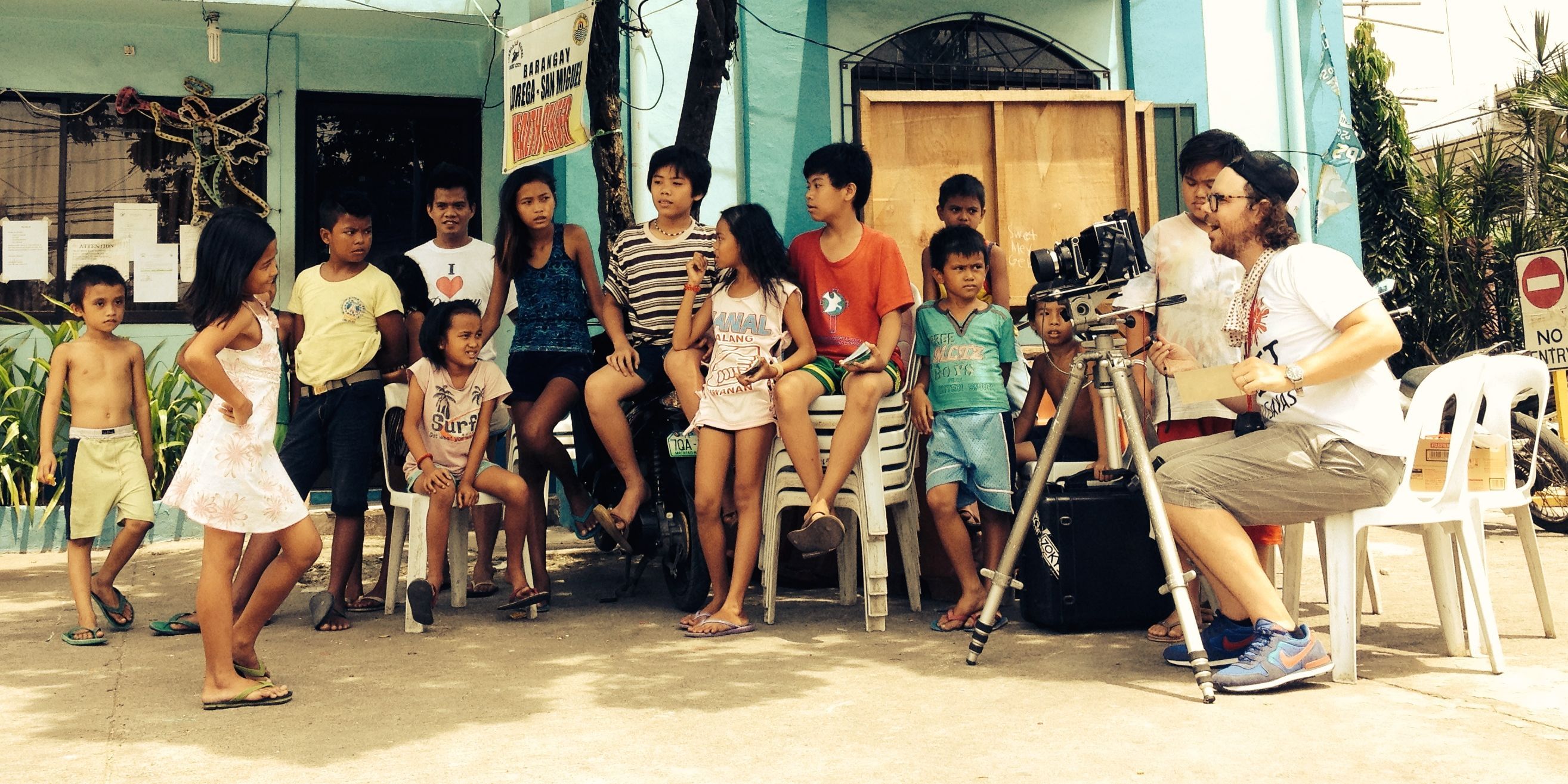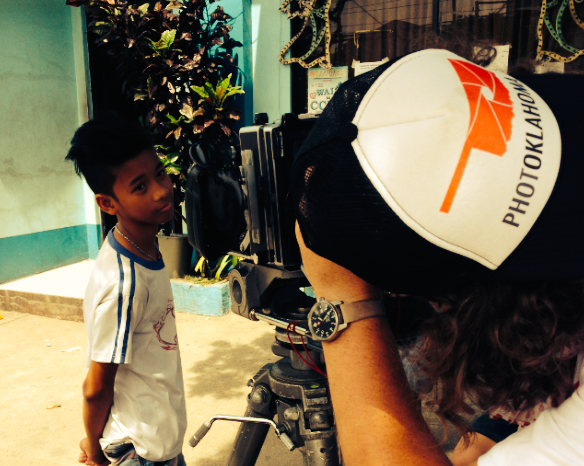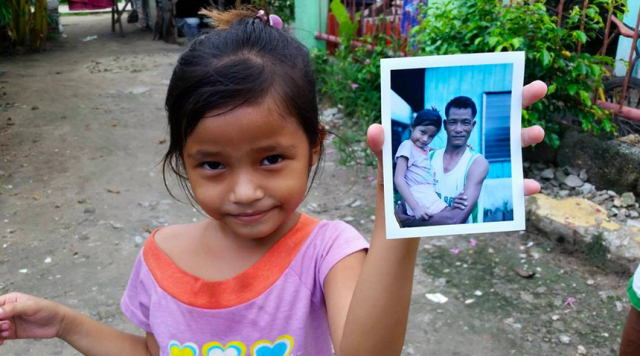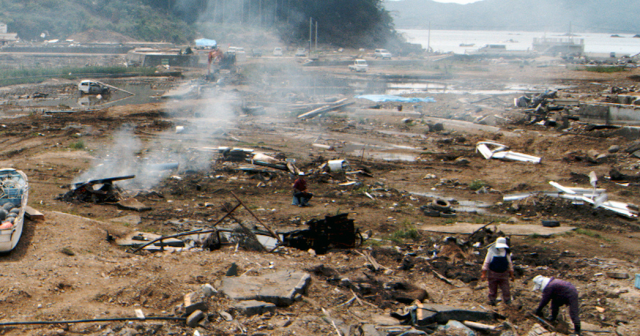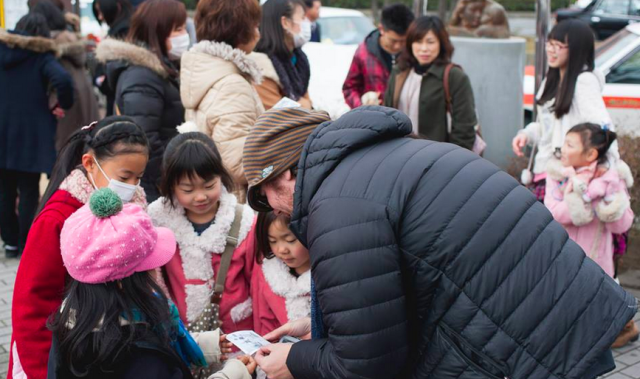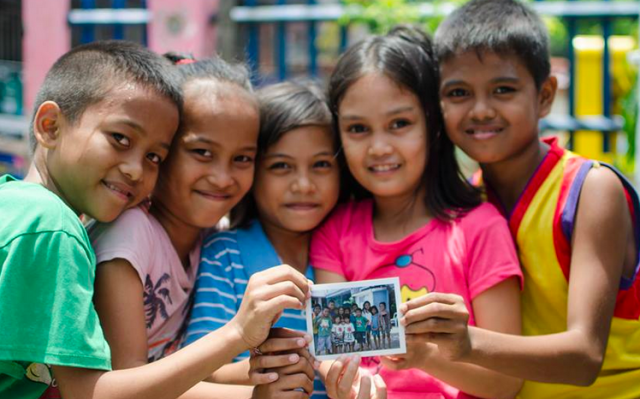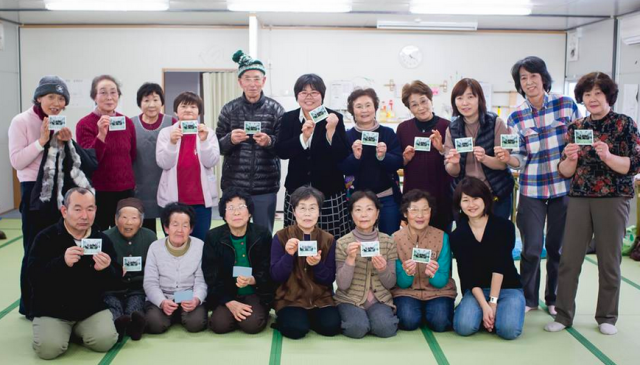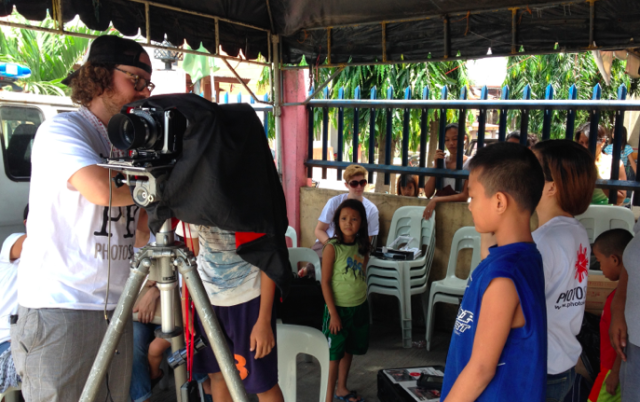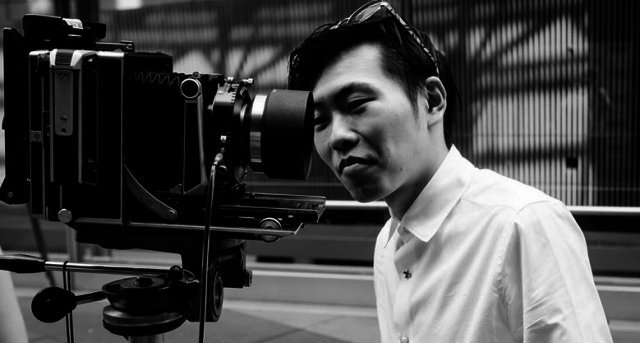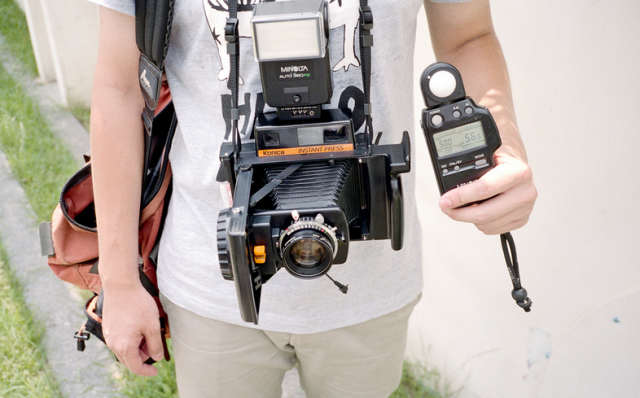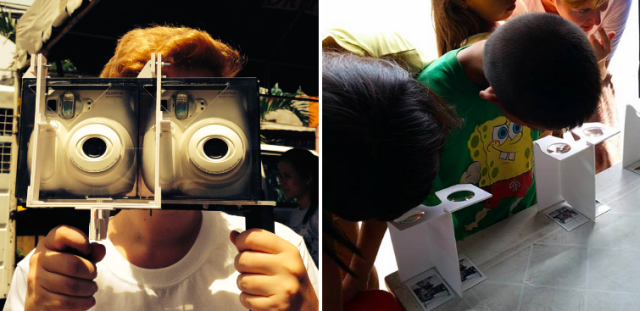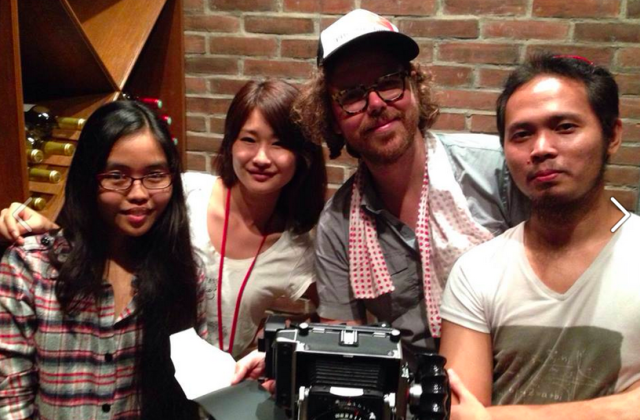Photohoku is a non-profit project that's making good use of old camera technology (namely instant cameras) in an attempt to give back some of the memories and sentimental items that have been lost in disasters around the globe.
Beginning in Japan, and gradually expanding to other countries, the project has big ambitions. The team behind Photohoku have already gifted over 10,000 instant photos, almost 1000 photo albums, and 100 digital cameras to the public, and touched the lives of thousands.
We recently got the chance to chat with co-founder Brian Scott Peterson about how the project started, the tech they're using, and what they're trying to accomplish.
The Photohoku Project
With the viewfinder of a home-made instant 3D camera glued to my right eye, two instant polaroids whirr upwards from the top of the plastic jig. A minute later, the gaggle of kids I’d just directed to pose like superheroes pour over the side-by-side polaroids with makeshift 3D glasses to see the novelty. Laughing and teasing, they call their parents over to witness them in all their three-dimensional glory.
Behind me, huddled under the only shade in the scorching square, another group of kids, friends, parents and grandparents giggle over the professional attention photographer Brian Scott Peterson is giving his next subject. With their hair now carefully coiffed, and head tilted just so, he quickly adjusts the focus on his beautifully vintage instant camera and snaps another stunning black and white portrait. As soon as the photo develops, it’s placed straight into the hands of the proud subject to act as a reminder of the day, and that life doesn’t always have to be a struggle. No other copies exist.
This is just another day in the life of Photohoku, the growing non-profit brain-child of professional photographers Brian Peterson, Yuko Nekabe Yoshikawa (who also runs a photography agency in Tokyo), and a handful of dedicated volunteers. The project sees the team transporting refurbished, beautifully retro instant cameras (and a few more modern pieces of kit) to a carefully select group of locations around the world, using the joy of portrait photography to bring light to areas where it may no longer shine so bright. Whether that’s within the disaster zone of Japan’s devastating tsunami of 2011, the aftermath of deadly Tornados in Oklahoma, or the destruction of Cebu City's fire in 2014.
When I first heard the chief behind Photohoku’s Phillipine efforts (also known as Photosayas), Jesslee Cuizon, describe the dreams and hopes of the project during a Pecha Kucha night in Cebu City, however, I was tentative. I was dubious about how snapping a few portraits of families and individuals among a (literally) burned out community could be a serious offer of hope. Over a glass of red, Jesslee had – before I knew it – convinced me to tag along to the first Photohoku event in the Philippines (to be known as Photosayas). A few days later, I was quizzing the team between water-breaks, photo shoots, and over email.
Losing Everything
I asked Brian about the genesis of the project, and what pushed Yoku to insist that they both do something together to help. He told me:
"Photohoku started in response to the March 11, 2011 Great Tohoku Earthquake and Tsunami disaster in Japan. The entirety of Japan was rattled after that earthquake and it felt like everybody wanted to rally to help to do something, including us. We [Brian and Yoku] worked separately and together in Tokyo on a handful of photography related projects, like a charity shoot, an auction, and a book, trying to raise money for Tohoku. Those first efforts, while successful, ran out of steam quickly. Yuko got frustrated that it wasn’t directly effective enough, and recruited me to go up there with her to do what we do professionally together in Tokyo – making family portraits. If people lost everything in the tsunami, it likely included their family histories in photos, and that was something we understood and could help with."
It's reported that almost $1bn USD was donated as aid to help the victims of the 2011 Earthquake (in which over 20,000 people were killed or are still missing). Understandably, the vast majority of this aid is syphoned toward rescue, food, and medical efforts. All worthy causes, by any standard. But one gaping hole in the way these funds are often distributed is the lack of focus on the rebuilding of personal lives.
There is close to no real focus on dealing with the loss of everything you held dear. Every item that was sentimental, gone. For many, losing the building they called 'home' pales in comparison to losing their family’s tangible history. Their great-grandmother’s wedding ring, or the love-letters from a long-perished romance. A house is replaceable. An infection is curable. Hunger is satiable. A lost history is none of these things.
One of the only rays of hope we see here are projects like the Memory Salvage Project (supported in part by Fujifilm) where physical photos recovered from disaster zones are digitally imported into a huge database and cross referenced with GPS coordinates based on where they were found. This enables families to later find and claim their own lost photos based on where they used to live, along with facial recognition software. As of 2012, over 30,000 photos had been reunited with their original owners. In Brian's words, this made Fujifilm’s teaming up with Photohoku "a perfect dovetail, both looking back and looking forward."
The Real-Life Results
When people (victims) are thrust into these disastrous situations, having a snap taken of them by some outsider who just doesn’t get it (often how they see the Photohoku team) is akin to a slap in the face. "They assumed we were perhaps some foreign news outlet, and having already been mined for media photos, they were not only not interested, but flat-out ignored us when asked to pose for photos that we’d gift to them," said Brian.
Fortunately though, when the team first visited the devastated scenes and temporary housing in and around Tohoku, Brian said he “eventually just made a snap of somebody and luckily it turned out great."
"Like magic, we handed the instant photo to the guy, and initial confusion instantly changed to happiness and he was beaming. "For me?" he asked. "Yeah man, just for you." As soon as everybody 'got it', everyone wanted one and we were very happy to oblige."
Since that first visit to Tohoku, Brian, Yuko and their volunteers have revisited the area and affected families over 50 times; gifting photographs, albums and digital cameras to (if only in a small way) help with the "mountain of grief and loss these people faced."
During the day I spent with Photohoku, the scenes were mirrored almost identically. At the beginning, there’s a reluctance. A caution about what we were actually doing, lugging strange-looking camera equipment into a desecrated community, setting up shop in the local square, and instructing the kids to go get your families! Who wouldn’t be dumb-founded?
Once the momentum grew, however (in large part thanks to Brian’s infectious enthusiasm and novel hats), the scene was set for fun, laughter and playfulness. And with it, came the opportunity to offer these families, through the medium of photography, at least some form of replacement for a small part of what they had lost in the fires that razed their homes to the ground.
In effect, This is a project that seems to be replicable anywhere, and in a plethora of different situations.
According to Brian, "it’s also welcomed by those with sickness, separated from family, faced with any kind of adversity. All can experience some kind of healing or solace from something as seemingly insignificant as a photo."
That is, the simple act of taking the time to hear stories, and out of them craft something beautiful, then gift that beauty straight back to the subject, is an act of generosity that does not go unnoticed.
No matter how dubious I was in the beginning, after my day helping (playing?) in Cebu City with Brian, Yuko and Jesslee, I was a convert to Brian’s way of thinking.
The Cameras
One thing that makes this project really stand out, is the sheer dedication to instant photography. The reasons why this tech is central to the project are numerous. From being able to gift photos and albums to families instantly, to seeing everybody’s eyes light up at the sight of a Linhof Master Technika. This is kit that the younger generation have never set eyes on and the older "haven't seen it in a million years."
"The cameras are weird accordion-looking things that can intrigue people and break the ice when they see us pulling actual photos right out of the cameras. Each photo we make takes several minutes to develop and that gives us important time to connect with the affected people, hear their stories and struggles, all while an anticipation and excitement builds to see the photo.
You could even argue Photohoku is a kind of distraction, albeit short, from the reality of the situation, like the cinema can be for a stressful day.
Once the photo has had time to develop, depending on the temperature, we hand the photo to the recipients for them to peel apart with a flourish themselves. If it’s a really great photo, you can see how their whole world just melts away for a moment.
It's not too hard to understand that this is far more romantic and dynamic than waiting for an inkjet printer to digitally and robotically spit out line after line of CMYK."
It’s no secret that there’s an in-built romanticism about retro, hipster-looking photos, and this is true for their analogue equivalent, too. Look at the success of Instagram (read our tutorial here), and the incessant filterization of digital photos (guilty – shoot me) permeating social media. But actually seeing, first hand, the creation of an analogue photo, taken by a truly talented photographer is indeed something magical. As Brian makes clear, "The photos don’t just spit out of the camera, then slowly appear after a few minutes. You have to manually pull the photos out of the cameras, wait a few minutes, and peel them apart”.
Luckily for Photohoku, Fujifilm (the sole remaining provider of this professional grade 'peel-apart' instant film, known as “FP”), was kind enough to donate a hefty stash of the stuff, saying "You guys just keep focusing on what you’re doing and we got your back.” – thereby enabling this magic to be experienced by thousands.
It’s mainly when you bring up the topic of the cameras used by Photohoku, however, that you see Brian's true passion for (and obsession with) photography in all it’s glory. One of the mainstays of Photohoku’s selection of equipment is the Konica Instant Press (of which the team has three), the history of which Brian excitedly reels off at length.
"This is just an oddball camera that never really made big waves in the camera world, but now is a highly collectable thing. The form factor harkens back to a camera called the Polaroid Pathfinder (or 110 or 120) which took a (long since discontinued) roll-type Polaroid film. In my opinion, the Pathfinder is one of, if not the prettiest cameras ever made, certainly the prettiest American camera in history. It probably came out of the 50s-60s space-race era when everything looked like rockets, and it has beautiful lines like a Cadillac, built like a tank. A real gem of a camera if you can find one that has been converted to the modern type film.
But anyway, the Konica Press is the funky early 80’s version of the Pathfinder. Very Japanesey and kinda more ray-gunny. And the lens, it’s the most unsung, underdogged, glorious little lens. It’s, by a landslide, my favorite camera, and I’ve used many. Its not that it’s better than other cameras, its just that it matched me, which I think is important.”
On top of the Konica Instant Press, the team also uses other gems including the Linhof Master Technika (image above), made in West Germany (the team’s main, 4x5 camera which takes sheet film negatives). This is "as heavy-duty as you can get. But drives like a Porsche, with an amazing Schneider 150 mm Xenotar high speed lens which has made some of the most beautiful portraits we’ve taken. Its hands-down one of the finest modern lenses ever produced”.
Also in use, on top of Swiss-made Sinars, Polaroid Land cameras, old American Speed Graphics, and all kinds of of other exciting toys, is the Mamiya Universal system. Arguably "the most modular camera system ever made, with 100+ accessories and beautiful lenses, it's the workhorse camera of 60s-70s Japan”.
Finally, the camera I personally had the chance to play with in the Philippines is a homemade stereoscopic instant camera (below). "Its actually a housing that holds two little Fujifilm Cheki [Broken URL Removed] cameras and makes two instant photos at the same time”. To view the photos in 3D, a couple of cheap magnifying lenses are taped into makeshift origami-style frames to create a viewer for the two photos. "It's really fun to watch people's reaction to seeing themselves popping out of the photos in 3D. Lots of oohs and ahs!"
With all the excitement over the antique kit that’s being set up, oft-times in the middle of a disaster zone, it’s sometimes too easy to look past the bigger picture though. This is much, much more than simply heading out with some cool cameras to shoot some black and white portraits. After all, the photographers involved with the project don’t even keep a copy of the photos for themselves.
Photohoku is a project aimed at introducing some lost hope and escapism back to lives where it has recently been dissolved. In communities where fun has become taboo, and where sentimentalism is a luxury that can’t be afforded, this project is a welcome break to those who need it most. A break that inserts some momentum in the rebuilding of personal lives, rather than solely the bricks and mortar of collapsed buildings. And what’s more, it’s working.
Since the project’s inception in Japan, Brian and Yuko have run events in Oklahoma (Photoklahoma), and helped to organise events in the Philippines (Photosayas), along with Jesslee Cuizon. But, as Brian predicts, “the ways that this kind of photography can help people is only limited by our imagination”.
To prove this point, the team has also "visited several orphanages, as well as couple of elderly assisted-living type places. We’ve also been invited by a children’s hospital for cancer patients who can’t be with their families all the time. There are simply countless ways to work and we feel like we are just getting started."
How You Can Help
Wherever we turn these days, modern tech is infiltrating all aspects of our lives. We take for granted our ability to store so many of our memories and conversations 'in the cloud'. But when disaster strikes, we're reminded just how fickle, easily destroyed and difficult to replace our tangible, sentimental memories really are, unless of course you’re lucky to be covered by the Memory Salvage Project.
Photohoku is one of the only projects we've seen that's using tech (old tech, at that) to help individuals and families to rebuild their lives, and to give back a small portion of what they lost. This could be time with family, sentimental photos, or simply a recent, happy memory.
To find out more about Photohoku and to see more of what they're up to and how you can help out, check out their free iPhone app [No longer available], e-book, Facebook, Twitter and website. And if you feel like setting up your own Photohoku event, go ahead, polish up your photography skills, and get in touch with Brian.
Image Credits: Photohoku.org, Stan Chow via Flickr, Lordcolus via Flickr.

